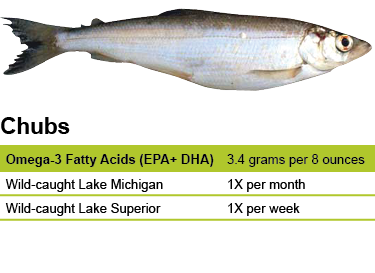CONSUMPTION ADVICE
State health agencies have found that it is safe to eat Lake Superior bloaters once a week and Lake Michigan bloaters once a month. If you are unsure of the origin of your chubs, you should follow the most restrictive recommendation (once a month).
Visit these links to find out more information about fish advisories in Wisconsin and the Great Lakes:
Wisconsin Department of Natural Resources: Eating Your Catch
BIOLOGY AND HISTORY
Historically the bloater was a small chub (cisco) species of little value. However, environmental advantages have resulted in increasing numbers and size, and the bloater has become the most important species of chub (cisco) remaining in the fisheries of Lakes Michigan and Superior. In Lake Michigan, bloaters exploded in numbers because their top predator, the lake trout, was disappearing from overharvest and sea lamprey predation. In Lake Superior, bloaters became prominent because larger species were overharvested.
Like many Great Lakes fish, the bloater population has always had cyclical highs and lows. There is some evidence of peaks in both 1960 and 1990, possibly indicating a 30-year cycle. However, the invasion of zebra and quagga mussels in Lake Michigan affected this natural cycle, possibly because the two mussels compete with young chubs for food. Since the 1990s, bloater numbers have been in decline. Scientists are trying to find out if bloater chubs will rebound on their own as they have done historically.

